CADILLAC XLR V 2007 1.G Owners Manual
Manufacturer: CADILLAC, Model Year: 2007, Model line: XLR V, Model: CADILLAC XLR V 2007 1.GPages: 512, PDF Size: 3.84 MB
Page 151 of 512

Adaptive Cruise Control is an enhancement to
traditional cruise control and is not a safety
system. It allows you to keep cruise control
engaged in moderate traffic conditions without
having to constantly reset your cruise control.
Adaptive Cruise Control uses radar to detect a
vehicle directly ahead in your path, within a
distance of 328 ft (100 m), and operates at speeds
above 25 mph (40 km/h). When it is engaged by
the driver, the system can apply limited braking or
acceleration of the vehicle, automatically, to
maintain a selected follow distance to the vehicle
ahead. Braking is limited to 0.3 g’s (2.95 m/sec2)
of deceleration, which is comparable to moderate
application of the vehicle’s brakes. To disengage
Adaptive Cruise Control, apply the brake. If there is
not a vehicle in your path, your vehicle will react
like traditional cruise control.
{CAUTION:
Adaptive Cruise Control will not apply
hard braking or bring the vehicle to a
complete stop. It will not respond to
stopped vehicles, pedestrians or animals.
When you are approaching a vehicle or
object, Adaptive Cruise Control may not
have time to slow your vehicle enough to
avoid a collision. Your complete attention
is always required while driving and you
should be ready to take action and apply
the brakes. For more information, see
Defensive Driving on page 322.
151
Page 152 of 512

{CAUTION:
On winding roads, Adaptive Cruise
Control may not detect a vehicle
ahead. You could crash into a vehicle
ahead of you. Do not use Adaptive
Cruise Control on winding roads.
Adaptive Cruise Control may not have
time to slow your vehicle enough to
avoid a crash when you are driving in
conditions where vehicles may
suddenly slow or stop ahead of you,
enter your lane, or cross your vehicle’s
path. If you are driving in these
conditions, do not use Adaptive Cruise
Control. The warning beep and alert
symbol may indicate that you are
driving in conditions where Adaptive
Cruise Control should not be used. See
“Alerting the Driver” in this section.
CAUTION: (Continued)
CAUTION: (Continued)
On slippery roads, fast changes in tire
traction can cause needless wheel
spinning, and you could lose control.
Do not use cruise control on slippery
roads.
When weather limits visibility, such as
when in fog, rain, or snow conditions,
Adaptive Cruise Control performance
is limited. There may not be enough
distance to adapt to the changing
traffic conditions. Do not use cruise
control when visibility is low.
Some of the Adaptive
Cruise controls are
located on the end of
the multifunction lever.
152
Page 153 of 512

9(Off):This position turns the system off.
R(On):This position turns the system on.
S(Resume/Increase):Push the switch to this
symbol to make the vehicle resume to a previously
set speed or to increase the set speed when
Adaptive Cruise Control is already active.
T(Set/Decrease):Press this button to set the
speed or to decrease the set speed when
Adaptive Cruise Control is already active.
Engaging Adaptive Cruise Control With
the Set Button
{CAUTION:
If you leave your Adaptive Cruise Control
switch on when you are not using cruise,
you might hit a button and go into cruise
when you do not want to. You could be
startled and even lose control. Keep the
Adaptive Cruise Control switch off until
you want to use cruise control.
{CAUTION:
If you operate Adaptive Cruise Control
without your Head-up Display (HUD) on
and properly adjusted, your Adaptive
Cruise Control settings will not be visible.
You could forget your settings and be
startled by Adaptive Cruise Control
response and even lose control. Keep
your HUD on and properly adjusted when
using Adaptive Cruise Control.
The set speed is selected by the driver. This is the
speed you will travel if there is not a vehicle
detected in your path.
To set Adaptive Cruise Control, do the following:
1. Make sure the Head-Up Display (HUD) is
on and properly adjusted. SeeHead-Up
Display (HUD) on page 171for more
information.
2. Move the switch to on.
153
Page 154 of 512
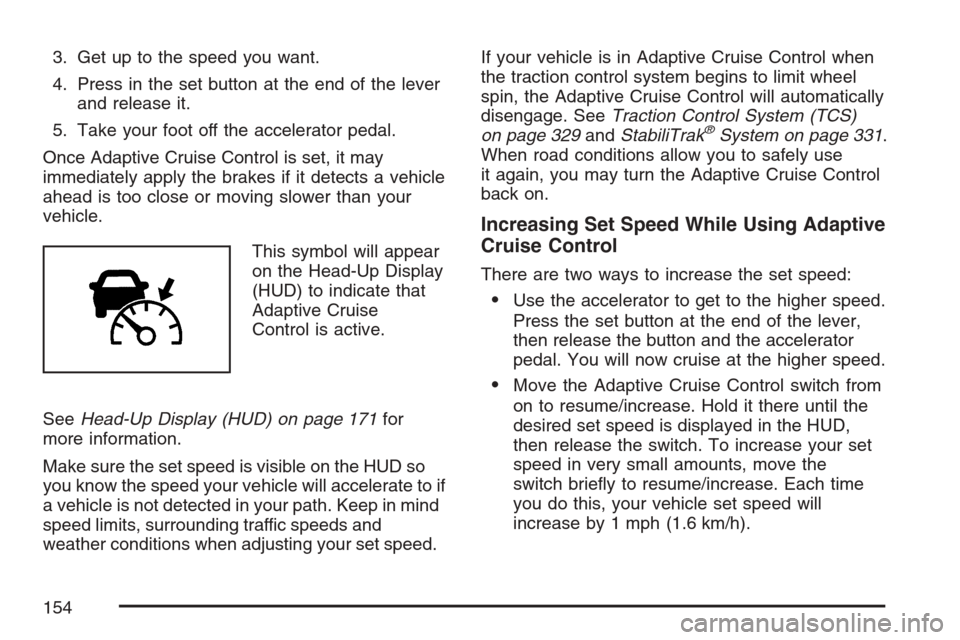
3. Get up to the speed you want.
4. Press in the set button at the end of the lever
and release it.
5. Take your foot off the accelerator pedal.
Once Adaptive Cruise Control is set, it may
immediately apply the brakes if it detects a vehicle
ahead is too close or moving slower than your
vehicle.
This symbol will appear
on the Head-Up Display
(HUD) to indicate that
Adaptive Cruise
Control is active.
SeeHead-Up Display (HUD) on page 171for
more information.
Make sure the set speed is visible on the HUD so
you know the speed your vehicle will accelerate to if
a vehicle is not detected in your path. Keep in mind
speed limits, surrounding traffic speeds and
weather conditions when adjusting your set speed.If your vehicle is in Adaptive Cruise Control when
the traction control system begins to limit wheel
spin, the Adaptive Cruise Control will automatically
disengage. SeeTraction Control System (TCS)
on page 329andStabiliTrak
®System on page 331.
When road conditions allow you to safely use
it again, you may turn the Adaptive Cruise Control
back on.
Increasing Set Speed While Using Adaptive
Cruise Control
There are two ways to increase the set speed:
Use the accelerator to get to the higher speed.
Press the set button at the end of the lever,
then release the button and the accelerator
pedal. You will now cruise at the higher speed.
Move the Adaptive Cruise Control switch from
on to resume/increase. Hold it there until the
desired set speed is displayed in the HUD,
then release the switch. To increase your set
speed in very small amounts, move the
switch brie�y to resume/increase. Each time
you do this, your vehicle set speed will
increase by 1 mph (1.6 km/h).
154
Page 155 of 512
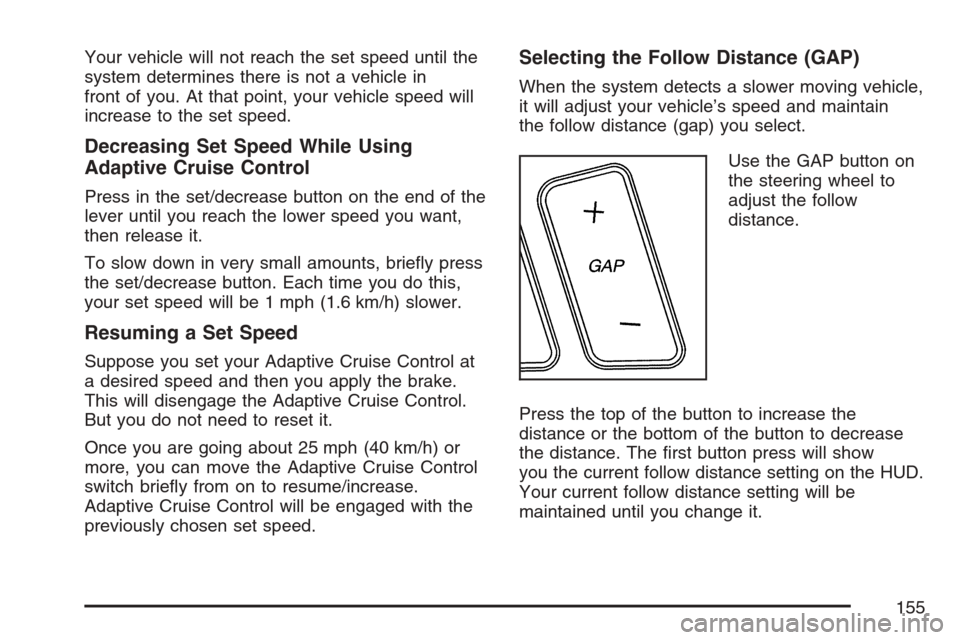
Your vehicle will not reach the set speed until the
system determines there is not a vehicle in
front of you. At that point, your vehicle speed will
increase to the set speed.
Decreasing Set Speed While Using
Adaptive Cruise Control
Press in the set/decrease button on the end of the
lever until you reach the lower speed you want,
then release it.
To slow down in very small amounts, brie�y press
the set/decrease button. Each time you do this,
your set speed will be 1 mph (1.6 km/h) slower.
Resuming a Set Speed
Suppose you set your Adaptive Cruise Control at
a desired speed and then you apply the brake.
This will disengage the Adaptive Cruise Control.
But you do not need to reset it.
Once you are going about 25 mph (40 km/h) or
more, you can move the Adaptive Cruise Control
switch brie�y from on to resume/increase.
Adaptive Cruise Control will be engaged with the
previously chosen set speed.
Selecting the Follow Distance (GAP)
When the system detects a slower moving vehicle,
it will adjust your vehicle’s speed and maintain
the follow distance (gap) you select.
Use the GAP button on
the steering wheel to
adjust the follow
distance.
Press the top of the button to increase the
distance or the bottom of the button to decrease
the distance. The �rst button press will show
you the current follow distance setting on the HUD.
Your current follow distance setting will be
maintained until you change it.
155
Page 156 of 512

There are six follow distances to choose from. The
follow distance selection ranges from near to far
(1 second to 2 seconds follow time). The distance
maintained for a selected follow distance will
vary based on vehicle speed. The faster the
vehicle speed the further back you will follow.
Consider traffic and weather conditions when
selecting the follow distance. The range of
selectable distances may not be appropriate for all
drivers and driving conditions. If you choose to
travel at a distance farther than Adaptive Cruise
Control allows, disengage the system and
drive manually.
A graphic on the HUD indicates the selected
follow distance. This picture shows a maximum
follow distance. The vehicles will move closer
as you select a smaller follow distance.
156
Page 157 of 512
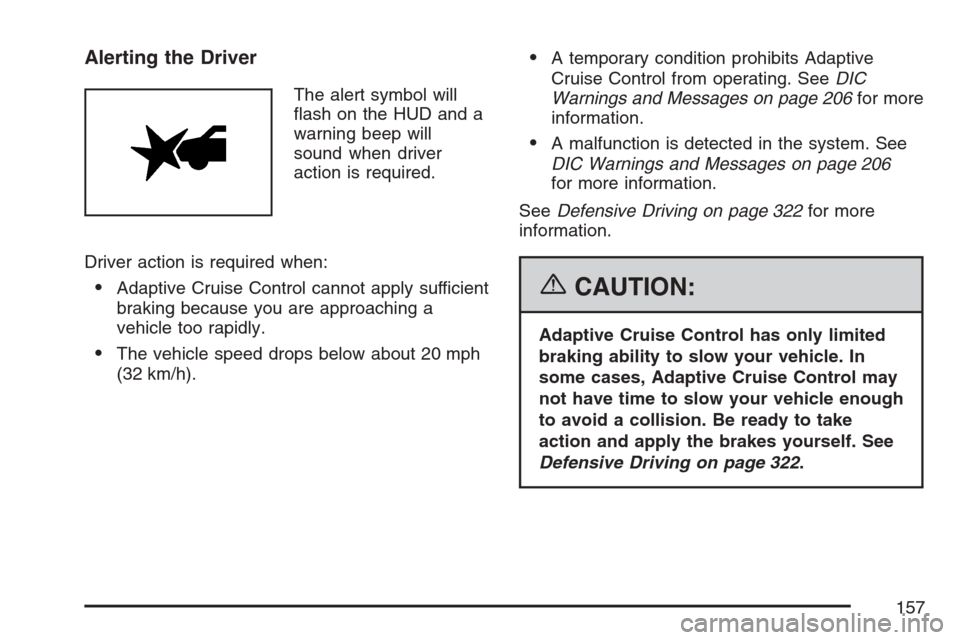
Alerting the Driver
The alert symbol will
�ash on the HUD and a
warning beep will
sound when driver
action is required.
Driver action is required when:
Adaptive Cruise Control cannot apply sufficient
braking because you are approaching a
vehicle too rapidly.
The vehicle speed drops below about 20 mph
(32 km/h).
A temporary condition prohibits Adaptive
Cruise Control from operating. SeeDIC
Warnings and Messages on page 206for more
information.
A malfunction is detected in the system. See
DIC Warnings and Messages on page 206
for more information.
SeeDefensive Driving on page 322for more
information.
{CAUTION:
Adaptive Cruise Control has only limited
braking ability to slow your vehicle. In
some cases, Adaptive Cruise Control may
not have time to slow your vehicle enough
to avoid a collision. Be ready to take
action and apply the brakes yourself. See
Defensive Driving on page 322.
157
Page 158 of 512
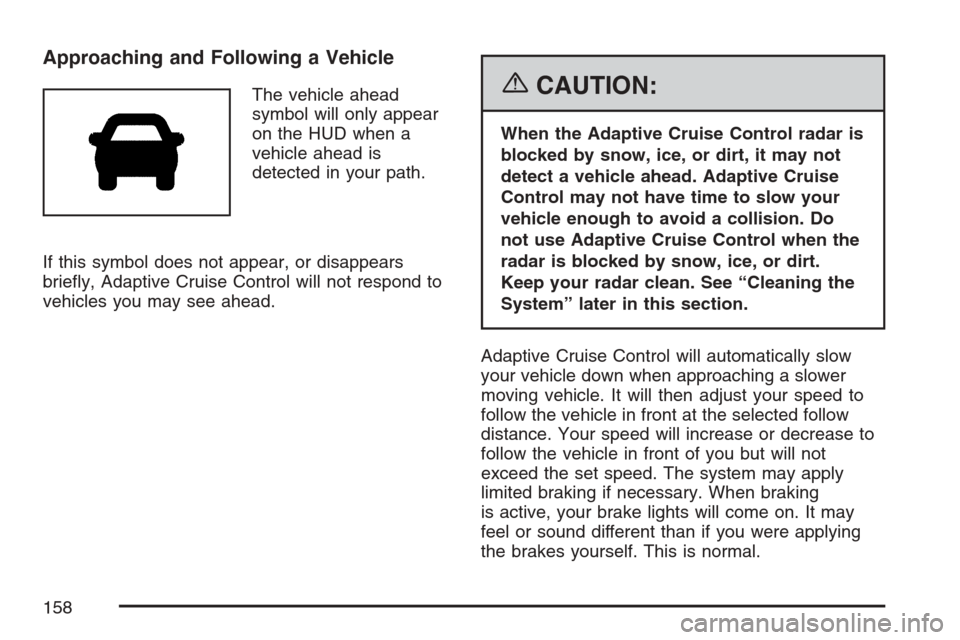
Approaching and Following a Vehicle
The vehicle ahead
symbol will only appear
on the HUD when a
vehicle ahead is
detected in your path.
If this symbol does not appear, or disappears
brie�y, Adaptive Cruise Control will not respond to
vehicles you may see ahead.{CAUTION:
When the Adaptive Cruise Control radar is
blocked by snow, ice, or dirt, it may not
detect a vehicle ahead. Adaptive Cruise
Control may not have time to slow your
vehicle enough to avoid a collision. Do
not use Adaptive Cruise Control when the
radar is blocked by snow, ice, or dirt.
Keep your radar clean. See “Cleaning the
System” later in this section.
Adaptive Cruise Control will automatically slow
your vehicle down when approaching a slower
moving vehicle. It will then adjust your speed to
follow the vehicle in front at the selected follow
distance. Your speed will increase or decrease to
follow the vehicle in front of you but will not
exceed the set speed. The system may apply
limited braking if necessary. When braking
is active, your brake lights will come on. It may
feel or sound different than if you were applying
the brakes yourself. This is normal.
158
Page 159 of 512
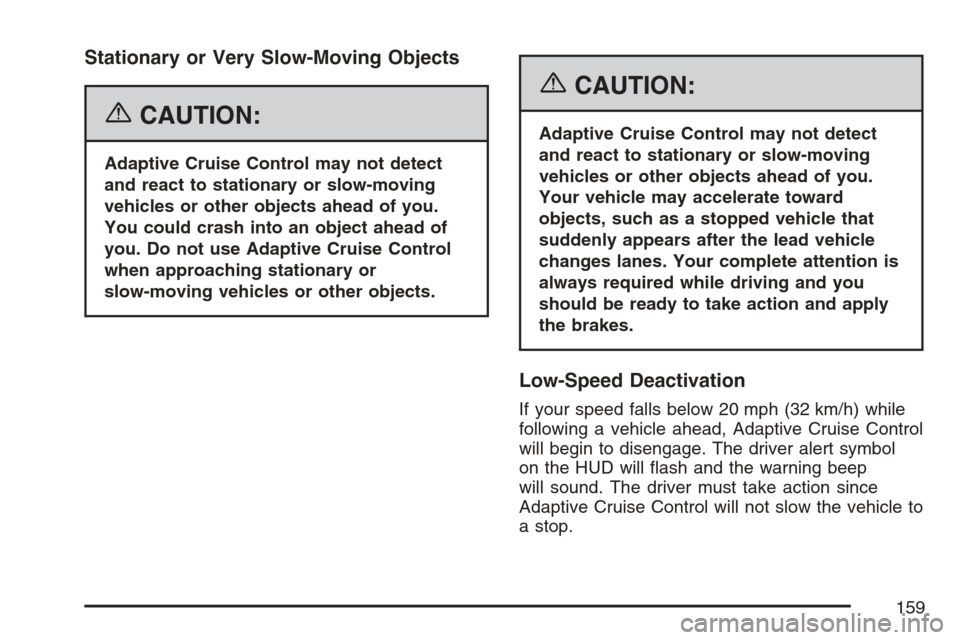
Stationary or Very Slow-Moving Objects
{CAUTION:
Adaptive Cruise Control may not detect
and react to stationary or slow-moving
vehicles or other objects ahead of you.
You could crash into an object ahead of
you. Do not use Adaptive Cruise Control
when approaching stationary or
slow-moving vehicles or other objects.
{CAUTION:
Adaptive Cruise Control may not detect
and react to stationary or slow-moving
vehicles or other objects ahead of you.
Your vehicle may accelerate toward
objects, such as a stopped vehicle that
suddenly appears after the lead vehicle
changes lanes. Your complete attention is
always required while driving and you
should be ready to take action and apply
the brakes.
Low-Speed Deactivation
If your speed falls below 20 mph (32 km/h) while
following a vehicle ahead, Adaptive Cruise Control
will begin to disengage. The driver alert symbol
on the HUD will �ash and the warning beep
will sound. The driver must take action since
Adaptive Cruise Control will not slow the vehicle to
a stop.
159
Page 160 of 512
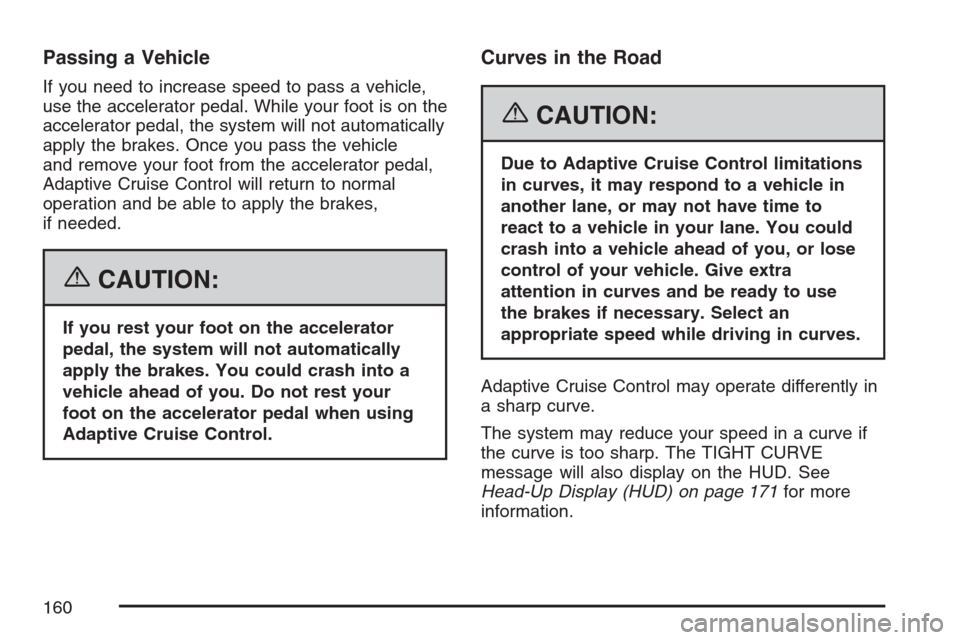
Passing a Vehicle
If you need to increase speed to pass a vehicle,
use the accelerator pedal. While your foot is on the
accelerator pedal, the system will not automatically
apply the brakes. Once you pass the vehicle
and remove your foot from the accelerator pedal,
Adaptive Cruise Control will return to normal
operation and be able to apply the brakes,
if needed.
{CAUTION:
If you rest your foot on the accelerator
pedal, the system will not automatically
apply the brakes. You could crash into a
vehicle ahead of you. Do not rest your
foot on the accelerator pedal when using
Adaptive Cruise Control.
Curves in the Road
{CAUTION:
Due to Adaptive Cruise Control limitations
in curves, it may respond to a vehicle in
another lane, or may not have time to
react to a vehicle in your lane. You could
crash into a vehicle ahead of you, or lose
control of your vehicle. Give extra
attention in curves and be ready to use
the brakes if necessary. Select an
appropriate speed while driving in curves.
Adaptive Cruise Control may operate differently in
a sharp curve.
The system may reduce your speed in a curve if
the curve is too sharp. The TIGHT CURVE
message will also display on the HUD. See
Head-Up Display (HUD) on page 171for more
information.
160